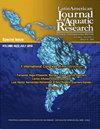Stressing stocking density and rearing time effect on whiteleg shrimp (Penaeus vannamei) reared intensively in floating cages
IF 0.8
4区 农林科学
Q3 FISHERIES
Latin American Journal of Aquatic Research
Pub Date : 2022-05-01
DOI:10.3856/vol50-issue2-fulltext-2814
引用次数: 2
Abstract
The stressing effect of stocking density and rearing time was assessed on shrimp Penaeus vannamei reared intensively in floating cages. Juvenile shrimp were stocked in 9 m2 cages at 200, 250, and 300 ind m-2 for a 25-day grow-out period. Total soluble protein concentration, superoxide dismutase (SOD), and catalase (CAT) activities were used as stress indicators in shrimp muscle, hepatopancreas, and hemocytes. Two-way ANOVA showed that protein content in hepatopancreas significantly decreased as stocking rate increased (from 3.81 to 2.26 mg mL-1). Density and rearing time interacted significantly to determine SOD activity in muscle and hemocytes where the maximum activity occurred at the densest rate by the end of the study (10.21 and 122.41 U mg-1); CAT activity in hepatopancreas was significantly lower when the highest density (4.1 U mg-1) was used. Final shrimp weight (5.28-5.49 g), survival (90.2-91.9%), feed conversion ratio (0.75-0.78), specific (0.058-0.063), and absolute (1.17-1.30 g week-1) growth rates were not significantly affected by density, although yields varied significantly (0.99-1.49 kg m-2). To conclude, despite the stocking rate causing a stressing effect on shrimp, its antioxidant enzymatic activity prevented such development from negatively affecting shrimp growth, survival, feed conversion ratio, and production.着重研究了浮动网箱集养凡纳白对虾的放养密度和饲养时间效应
以浮动网箱集养的凡纳滨对虾为试验对象,研究了放养密度和饲养时间的胁迫效应。稚虾分别在200、250和300 μ m-2的9 m2笼中放养,生长期为25 d。以虾肌肉、肝胰腺和血细胞的总可溶性蛋白浓度、超氧化物歧化酶(SOD)和过氧化氢酶(CAT)活性为应激指标。双因素方差分析显示,随着放养率的增加,肝胰脏蛋白质含量显著降低(从3.81 mg mL-1降至2.26 mg mL-1)。密度和饲养时间显著相互作用,决定了肌肉和血细胞中SOD活性,其中在研究结束时密度率最高(10.21和122.41 U mg-1);在最高浓度(4.1 U mg-1)时,肝胰脏CAT活性显著降低。密度对末重(5.28 ~ 5.49 g)、存活率(90.2 ~ 91.9%)、饲料系数(0.75 ~ 0.78)、比生长率(0.058 ~ 0.063)和绝对生长率(1.17 ~ 1.30 g周-1)影响不显著,但产量差异显著(0.99 ~ 1.49 kg m-2)。综上所述,尽管放养率对对虾产生应激效应,但其抗氧化酶活性阻止了应激效应对对虾生长、存活、饲料系数和产量的负面影响。
本文章由计算机程序翻译,如有差异,请以英文原文为准。
求助全文
约1分钟内获得全文
求助全文
来源期刊

Latin American Journal of Aquatic Research
FISHERIES-MARINE & FRESHWATER BIOLOGY
CiteScore
1.70
自引率
10.00%
发文量
44
审稿时长
4-8 weeks
期刊介绍:
Latin American Journal of Aquatic Research- LAJAR is the continuation of the journal Investigaciones Marinas (1970-2007) and is published since 2008 by the Escuela de Ciencias del Mar, Facultad de Ciencias del Mar y Geografía of the Pontificia Universidad Católica de Valparaíso. LAJAR is an “Open Access” journal that publishes in English language, original research articles, reviews and short communications on aquatic science, which contain the results of research conducted in aquaculture or in oceanic and coastal marine waters of Latin America.
The following topics are considered: Physical Oceanography, Chemical Oceanography, Marine Biogeochemistry, Marine Pollution and Toxicology, Marine Geology and Geophysics, Biological Oceanography, Fisheries and Aquaculture.
 求助内容:
求助内容: 应助结果提醒方式:
应助结果提醒方式:


